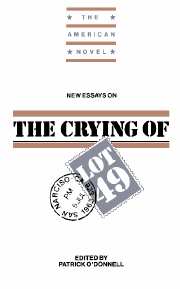Book contents
- Frontmatter
- Contents
- Series Editor's Preface
- 1 Introduction
- 2 Borges and Pynchon: The Tenuous Symmetries of Art
- 3 Toward the Schizo-Text: Paranoia as Semiotic Regime in The Crying of Lot 49
- 4 “Hushing Sick Transmissions”: Disrupting Story in The Crying of Lot 49
- 5 “A Metaphor of God Knew How Many Parts”: The Engine that Drives The Crying of Lot 49
- 6 A Re-cognition of Her Errand into the Wilderness
- Notes on Contributors
- Selected Bibliography
1 - Introduction
Published online by Cambridge University Press: 12 January 2010
- Frontmatter
- Contents
- Series Editor's Preface
- 1 Introduction
- 2 Borges and Pynchon: The Tenuous Symmetries of Art
- 3 Toward the Schizo-Text: Paranoia as Semiotic Regime in The Crying of Lot 49
- 4 “Hushing Sick Transmissions”: Disrupting Story in The Crying of Lot 49
- 5 “A Metaphor of God Knew How Many Parts”: The Engine that Drives The Crying of Lot 49
- 6 A Re-cognition of Her Errand into the Wilderness
- Notes on Contributors
- Selected Bibliography
Summary
Thomas Pynchon's second novel, The Crying of Lot 49, was published in 1966; that same year, the Manila Summit on America's increasing involvement in Vietnam took place, “Hogan's Heroes,” “Green Acres,” and “Gomer Pyle, U.S.M.C.” were top-rated television situation comedies, and Esquire published an article entitled “Wake Up America, It Can't Happen Here: A Post-McCarthy Guide to Twenty-Three Conspiracies by Assorted Enemies Within.” Such is the contemporary cultural context out of which Pynchon's enigmatic, conspiracy-ridden novel emerged — a novel which, in many ways, easily seduces us into linking an article in a popular magazine, television programs, and an historical event to the fortunes of a fictional character named Oedipa Maas. But it would be a mistake to assume that there is any definitive connection to be made between “fiction” and “history” by comparing the novel — in its moment of production — to the selected particularities of its cultural milieux. For The Crying of Lot 49 speculates upon the whole idea of “connection,” or the activity of connecting, as the characteristic human endeavor, whether it be in writing and reading literary works, or in articulating ourselves — our identities — as historical beings. We need to narrate, Pynchon's novel argues; we feel the necessity to create and perceive significant patterns in all that we read and do; we are driven to see the connections between the events of our own lives and the larger, external events of that unfolding story we call “history.”
- Type
- Chapter
- Information
- New Essays on The Crying of Lot 49 , pp. 1 - 20Publisher: Cambridge University PressPrint publication year: 1992

